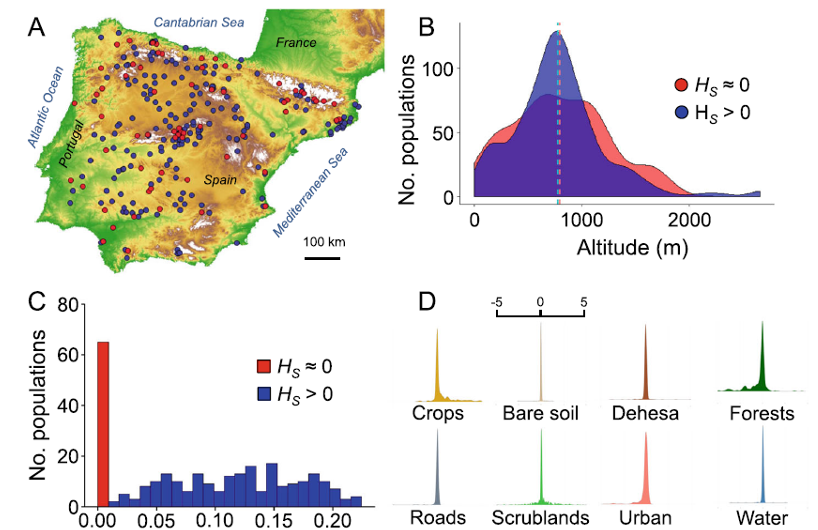Major drivers of genetic differentiation in Iberian Arabidopsis thaliana
Populations are not static, and the geographic distribution of genetic diversity within and among populations is changing continuously. The drivers of genetic differentiation is one of the cornerstones in evolution, as genetic diversity is paramount for the ability of populations to adapt and persist in changing environments. The spatio-temporal changes in genetic diversity constantly taking place in any population —regardless of the causes, pace and the phenotypic effects of such changes— constitute the raw material upon which natural selection eventually acts.
Now, a team of researchers has put three models to the test 1 in order to identify the major drivers of genetic differentiation in the annual plant Arabidopsis thaliana across the Iberian Peninsula.
The models
At any spatial scale, genetic diversity typically becomes unevenly distributed across space, because genetic diversity is determined by how it is partitioned within and among populations across the distribution. In other words, the spatial distribution of genetic diversity depends on the extent of genetic differentiation among populations whatever the sources of such differentiation are.
The inherent spatial nature of genetic differentiation defines the theoretical and methodological framework of three models, which are not mutually exclusive, testing the major drivers of genetic differentiation: isolation-by-distance (IBD), isolation-by-environment (IBE) and isolation-by-resistance (IBR) models.
In the classical IBD, genetic differentiation among populations exhibits a positive relationship with geographic distance. In this case, dispersal limitation and genetic drift determine the greater genetic differentiation at larger distances. In fact, limited dispersal constrains gene flow among populations, which is not able to counteract the effect of genetic drift within populations. Many types of organisms exhibit IBD, probably because unrestricted gene flow hardly occurs in nature. In any case, quantifying the contribution of limited dispersal and genetic drift to genetic differentiation is not a straightforward task, as we largely ignore some important variables.
In contrast, the IBE model deals with the effects of environmental differences on genetic differentiation. IBE posits that gene exchange is strongest among populations located in similar environments, which would be mediated by environmental heterogeneity, the extent of local adaptation and spatial variation in gene flow across space. Thus, genetic differentiation among populations increases with their environmental differentiation, independently of their geographic distance. IBE can arise due to multiple factors, such as biased dispersal due to preferences for particular environments, natural selection against maladapted immigrants, sexual selection against immigrants when they exhibit divergence in mating choices or sexual signals, and natural selection against hybrids when they show reduced fitness relative to non-hybrids.
Finally, the IBR model takes environmental heterogeneity across landscapes into account as a modulator of gene flow and its effects on genetic differentiation. The IBR model predicts a positive relationship between genetic differentiation and resistance distance among populations. The resistance distance between population pairs is a concept inspired in circuit theory, which considers the landscape features reducing the probability of dispersal and gene flow among populations. Under IBR, the spatial structure of habitat suitability is of paramount importance to determine the least cost path between population pairs optimizing their connectivity and thus minimizing their resistance distance. Given that the resistance distance between population pairs is a function of geographic distance, and that presence-background models estimate habitat suitability using environmental predictors, IBR inevitably conflates IBD and IBE.
Arabidopsis thaliana in the Iberian Peninsula
The Iberian Peninsula is the region of the Arabidopsis thaliana’s distribution harbouring the largest genomic diversity. Iberian A. thaliana occurs in a wide array of natural environments practically across the whole region, spanning from seaside to sub-alpine locations. These two features are likely the result of A. thaliana’s history in the Iberian Peninsula, where the species long survived by developing adaptations to ample environmental heterogeneity over dramatic climatic oscillations.

The occurrence of relict populations with an African origin also supports such history of Iberian A. thaliana. Overall, the geographic ubiquity, the large amount of genetic diversity, the broad variety of habitats occupied, and the long evolutionary history make Iberian A. thaliana an appropriate study system to disentangle the drivers of genetic differentiation at a regional scale.
Given the fact that a small sample size seriously reduces power and accuracy of spatial analyses, IBD, IBE and IBR were tested using 278 Iberian A. thaliana populations collected over a decade. About six individuals per population, totalling 1772 individuals, were genotyped to estimate genetic diversity, differentiation and structure.
The researchers hypothesized that IBD and IBE largely accounted for genetic differentiation for two reasons. The results showed that dispersal limitation, genetic drift, and, to a lesser extent, local adaptation to environmental gradients, accounted for the within- and among-population distribution of genetic diversity. Analyses applied to the four Iberian genetic clusters identified, which represent the joint outcome of the long demographic and adaptive history of the species in the region, showed similar results except for one cluster, in which IBR (a function of landscape heterogeneity) was the most important driver of genetic differentiation.
The team also employed a spatial hierarchical Bayesian model to identify regional hot and cold spots of genetic diversity and their potential environmental predictors. According to it, precipitation seasonality and topsoil pH chiefly accounted for the geographic distribution of genetic diversity in Iberian A. thaliana.
The interplay between the influence of precipitation seasonality on genetic diversity and the effect of restricted dispersal and genetic drift on genetic differentiation emerges as the major forces underlying the evolutionary trajectory of Iberian A. thaliana.
Author: César Tomé López is a science writer and the editor of Mapping Ignorance
Disclaimer: Parts of this article may be copied verbatim or almost verbatim from the referenced research paper.
References
- Antonio R. Castilla, Belén Méndez-Vigo, Arnald Marcer, Joaquín Martínez-Minaya, David Conesa, F. Xavier Picó and Carlos Alonso-Blanco (2020) Ecological, genetic and evolutionary drivers of regional genetic differentiation in Arabidopsis thaliana BMC Evolutionary Biology doi: 10.1186/s12862-020-01635-2 ↩